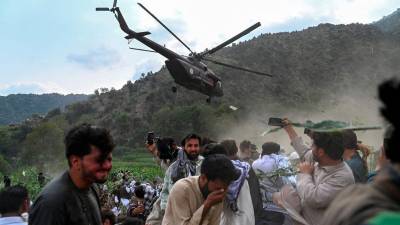
Afghanistan earthquake rescue efforts target remote mountain villages
KABUL/MAZAR DARA : Rescue teams in Afghanistan are attempting to reach isolated villages in the eastern Kunar region following a devastating earthquake that claimed over 800 lives and injured more than 2,800 people. Provincial disaster management head Ehsanullah Ehsan confirmed that rescue operations began in four villages on Monday and will now focus on more remote mountain areas. “We cannot accurately predict how many bodies might still be trapped under the rubble,“ said Ehsan. “Our effort is to complete these operations as soon as possible and to begin distributing aid to the affected families.” The magnitude 6 earthquake struck around midnight local time on Monday at a shallow depth of 10 kilometres, making it one of Afghanistan’s worst seismic disasters. Mountainous terrain and inclement weather have severely hampered rescue efforts in remote border areas with Pakistan where the quake destroyed numerous mudbrick homes. Ehsan identified vehicle access on narrow mountain roads as the primary obstacle for relief work, noting that machinery is being deployed to clear debris from routes. A Reuters witness observed a line of ambulances on damaged mountain roads attempting to reach Kunar villages while helicopters delivered aid supplies and evacuated the injured. Some injured individuals have been transferred to hospitals in Kabul and the adjacent Nangarhar province according to Ehsan. Taliban soldiers have been deployed to provide assistance and security in the affected areas, further testing the administration’s capacity amid reduced foreign aid and mass deportations. “National and international organisations are present in the area, have organised their assistance, and, God willing, aid will be distributed in an orderly manner,“ said Ehsan. United Nations officials noted that rescue teams are working to quickly dispose of animal carcasses to minimize water contamination risks. The World Health Organization highlighted significant challenges in aid delivery due to damaged roads, ongoing aftershocks, and remote village locations. “Damaged roads, ongoing aftershocks, and remote locations of many villages severely impede the delivery of aid,“ the World Health Organization said in a situation update, adding that over 12,000 people had been affected by the quake. “The pre-earthquake fragility of the health system means local capacity is overwhelmed, creating total dependence on external actors,“ said the update. Afghanistan’s location along the Hindu Kush mountain range, where tectonic plates meet, makes it particularly vulnerable to deadly earthquakes. This disaster follows a 6.1 magnitude earthquake in 2022 that killed 1,000 people in the eastern region, marking the Taliban government’s first major natural disaster challenge. – Reuters